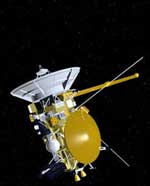
Image credit: NASA/JPL
The Sun ejected two massive flares towards the Earth last week, and NASA’s Cassini spacecraft listened in on the burst of radio waves that accompanied them. The radio waves took 69 minutes to reach Cassini, moving at the speed of light, and they sound a bit like the whoosh of a jet engine. The blast of radio waves was one of the largest ever recorded – a type 3 event. Cassini is on track to reach Saturn on July 1, 2004.
University of Iowa Professor and Space Physicist Dr. Don Gurnett used NASA’s Cassini spacecraft to record the sound of one of the largest solar flares seen in decades, as it moved outward from the Sun.
The sound can be heard online at: http://www-pw.physics.uiowa.edu/space-audio/.
NASA’s Solar and Heliospheric Observatory (SOHO) spacecraft captured this image of a solar flare, seen in the lower center of the image, as it erupted from the Sun early on Tuesday, October 28, 2003.
The radio wave burst, resembling the clicking of an old-fashioned telegraph machine followed by the rush of a jet engine, was recorded Oct. 28 by Cassini while on its way to a July 1, 2004, encounter with Saturn. Cassini will be the first orbiter to give us a close-up look at the ringed world and its moons. Its piggybacked Huygens probe, contributed by the European Space Agency, will descend through the smoggy atmosphere of Saturn’s moon Titan, impacting on what could be a liquid methane ocean.
Gurnett noted that the radio waves — moving at the speed of light — took just 69 minutes to reach the spacecraft, currently some 1.3 billion kilometers (809 million miles) from Earth.
“This is one of the biggest events of its kind ever seen,” said Gurnett. The event, described as a “type 3” radio burst, was detected using the Cassini radio and plasma wave instrument, largely built at the University of Iowa, and for which Gurnett serves as principal investigator.
“The sound is produced by electrons moving out from the solar flare, beginning at a high frequency before dropping to a lower frequency,” Gurnett said. Scientists monitoring the solar flare said that the massive cloud — composed of billions of tons of electrically charged particles — reached Earth on Oct. 29.
Cassini-Huygens is a cooperative mission of NASA, the European Space Agency and the Italian Space Agency. JPL, a division of Caltech, manages the mission for NASA’s Office of Space Science, Washington, D.C.
Original Source: NASA/JPL News Release
